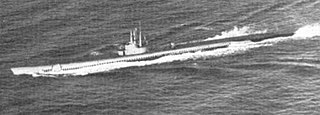
USS Skate (SSN-578) was the third submarine of the United States Navy named for the skate, a type of ray, was the lead ship of the Skate class of nuclear submarines. She was the third nuclear submarine commissioned, the first to make a completely submerged trans-Atlantic crossing, the second submarine to reach the North Pole, and the first to surface there.

USS Sailfish (SSR/SS/AGSS-572), the lead ship of her class of submarine, was the second ship of the United States Navy to be named for the sailfish, a large gamefish inhabiting tropical seas, related to the swordfish, but possessing scales and a large sail-like dorsal fin.

USS John Marshall (SSBN-611) was an Ethan Allen-class submarine, the only ship of the United States Navy to be named for John Marshall (1755–1835), the fourth Chief Justice of the United States. Originally a fleet ballistic missile submarine designated SSBN-611, she later was reclassified as an attack submarine and re-designated SSN-611.

USS Thomas Jefferson (SSBN-618), an Ethan Allen class nuclear-powered submarine, was the second ship of the United States Navy to be named for Founding Father Thomas Jefferson (1743–1826), the third President of the United States (1801–1809). She later was reclassified as an attack submarine and redesignated SSN-618.

USS Runner (SS/AGSS-476), a Tench-class submarine, was the second ship of the United States Navy to be named for the runner, an amberfish inhabiting subtropical waters.

USS Archerfish (SSN-678), a Sturgeon-class attack submarine, was the second ship of the United States Navy to be named for the archerfish, a family (Toxotidae) of fish notable for their habit of preying on insects and other animals by shooting them down with squirts of water from the mouth.

USS James K. Polk (SSBN-645), a Benjamin Franklin class fleet ballistic missile submarine, was the second ship of the United States Navy to be named for James K. Polk (1795–1849), the eleventh President of the United States (1845–1849). She was later converted into an attack submarine and redesignated SSN-645.

USS Skipjack (SSN-585), the lead ship of her class of nuclear-powered attack submarine, was the third ship of the United States Navy to be named after the skipjack tuna.

USS Sculpin (SSN-590), a Skipjack-class nuclear-powered submarine, was the second ship of the United States Navy to be named for the sculpin.

USS Snook (SSN-592), a Skipjack-class submarine, was the second ship of the United States Navy to be named for the common snook, an Atlantic marine fish that is bluish-gray above and silvery below a black lateral line.

USS Whale (SSN-638) was a Sturgeon-class submarine nuclear-powered attack submarine of the United States Navy. She was the second ship of that name, after the whale family of aquatic mammals.

USS William H. Bates (SSN-680), a Sturgeon-class attack submarine, was planned to be the second U.S. Navy ship to be named USS Redfish—for the redfish, a variety of salmon also called blueback, sawqui, red salmon, and nerka—when the contract to build her was awarded to Ingalls Shipbuilding in Pascagoula, Mississippi, on 25 June 1968. However, upon the 22 June 1969 death of William H. Bates (1917–1969), the U.S. representative from Massachusetts's 6th congressional district (1950–1969) known for his staunch support of nuclear propulsion in the U.S. Navy, she was renamed William H. Bates and was laid down on 4 August 1969 as the only ship of the U.S. Navy to have borne the name. The reason for her naming by then-Secretary of the Navy John Chafee, breaking with a long-standing Navy tradition of naming U.S. Navy attack submarines for sea creatures, was best summed up by Admiral Hyman Rickover, the then-director of the Navy's nuclear reactors program, with the pithy comment that, "Fish don't vote!"

USS Sturgeon (SSN-637), was the lead ship of her class of nuclear-powered attack submarines. She was the third ship of the United States Navy to be named for the sturgeon.

USS Spadefish (SSN-668), a Sturgeon-class submarine, was the second ship of the United States Navy to be named for the spadefish, a spiny-finned fish found in coastal waters of the western Atlantic from Cuba to Cape Cod.

USS Sunfish (SSN-649), a Sturgeon-class attack submarine, was the second ship of the United States Navy to be named for the ocean sunfish, a marine species having a deep body truncated behind, and high dorsal and anal fins.

USS Ray (SSN-653), a Sturgeon-class attack submarine, was the second ship of the United States Navy to be named for the rays.

USS Seahorse (SSN-669), a Sturgeon-class attack submarine, was the second submarine and third ship of the United States Navy to be named for the seahorse.

USS Sea Leopard (SS-483), a Tench-class submarine, was the only ship of the United States Navy to be named for the leopard seal. Her keel was laid down by the Portsmouth Navy Yard on 7 November 1944. She was launched on 2 March 1945 sponsored by Hon. Margaret Chase Smith, United States Congresswoman from Maine, and commissioned on 11 June 1945.

USS Robert A. Owens (DD/DDK/DDE-827) was a Gearing-class destroyer of the United States Navy, in service from 1949 to 1982. The ship was named for United States Marine Corps Medal of Honor recipient Robert A. Owens. The ship was then transferred to Turkey through the Security Assistance Program (SAP) and served as TCG Alcitepe (D-346). The destroyer was finally decommissioned in 1999 and scrapped.

USS Waccamaw (AO-109) was a Cimarron-class replenishment oiler in the United States Navy. She was named after Waccamaw River. The original capacity was 146,000 barrels (23,200 m3).




















